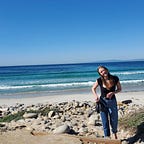National Geographic: Publication Analysis
In this project, our group ( Jess, Ana, Susan, and myself) worked on analyzing and presenting the attributes of National Geographic.
Initial Thoughts on Project:
In our initial discussion of the publication, we went through both the print and web versions and came up with a few notes on each. We then went through and talked about what made them similar or what distinguished them from one another.
- Inconsistency of typeface — combination of Serif and Sans serif
- A lot of photo usage
- Even margins
- Switches tone from article to article
- Online providing more autonomy than the print
Establishing Hypothesis:
After looking at our categories and our slides, we realized that our presentation lacked a hypothesis. This made our presentation less focused so we jotted some ideas onto the white board and wrote the ways the design supported the content. We then decided that the content section could also help us finalize the adjectives used to describe our publication. Our main hypothesis then became “National Geographic uses imagery, adaptive type, color, and grid systems to create a photo driven publication.”
There are many aspects of National Geographic that are important to its essence, but one that stuck out to us was its photography usage. That is really what makes it stand apart from other magazines since they show more instead of telling. In this realization, we found that the photos are the main focus in the magazine and the type is used to complement it. This is the main reason why we created this as the center of our hypothesis.
Initial Research:
To gather information for our presentation and outline what we want to cover, we created a shared document and jotted down some of the background info. We found this extremely helpful when trying to hypothesize the audience and also formulate our own claim.
Creating Content Categories:
In addition to the hypothesis, our group spent a while considering how we could break up the content in our presentation. In our discussion, we went through the ideas of having the adjectives drive the movement through the presentation, or just having broader terms to encompass the information. We decided that having background (including both history and mission statement), attributes, evidence, and conclusion would allow our group to move through the information in an organized and clear way.
Diving into Grid Systems:
Jess and I mainly focused on analyzing the print publication and Ana and Susan focused on the web versions. Jess and I went through and created a few grid systems for the spreads to see if there were any consistencies or patterns arose. We did notice that a lot of the time, a four column grid system is used in the publication, for both solely photo spreads, and also photo/story spreads. We mainly noticed two consecutive patterns within the text, the first being that usually when there is a pairing of both text and imagery, the imagery spans across the page, and the text stays within a four column grid system.
Post Critique Changes
After the critique, our group focused on mainly adding more examples of the text itself, rehearsing, looking into the grid systems a bit more, and cleaning up our graphics. We also focused on changing the flow and order of our slides to make transitions and topics more organized.
Reflection
I learned a lot about the more technical side of layout that I constantly take for granted. When I had to do spreads in high school or even last year, I would keep to the basics, but I never thought about proportions, headers, and all of those smaller relationships that actually make a huge difference on the page. I would focus more on making things look right than actually looking at the details and I think this project placed all of those considerations that I have to make in my lap a bit more. This was extremely eye opening for me, and I am really excited to bring more of this consideration to my design work! Also, this is less about technical aspects, but I really enjoyed working with our team. I think we all tried to think things through and consider many different aspects of the project!
